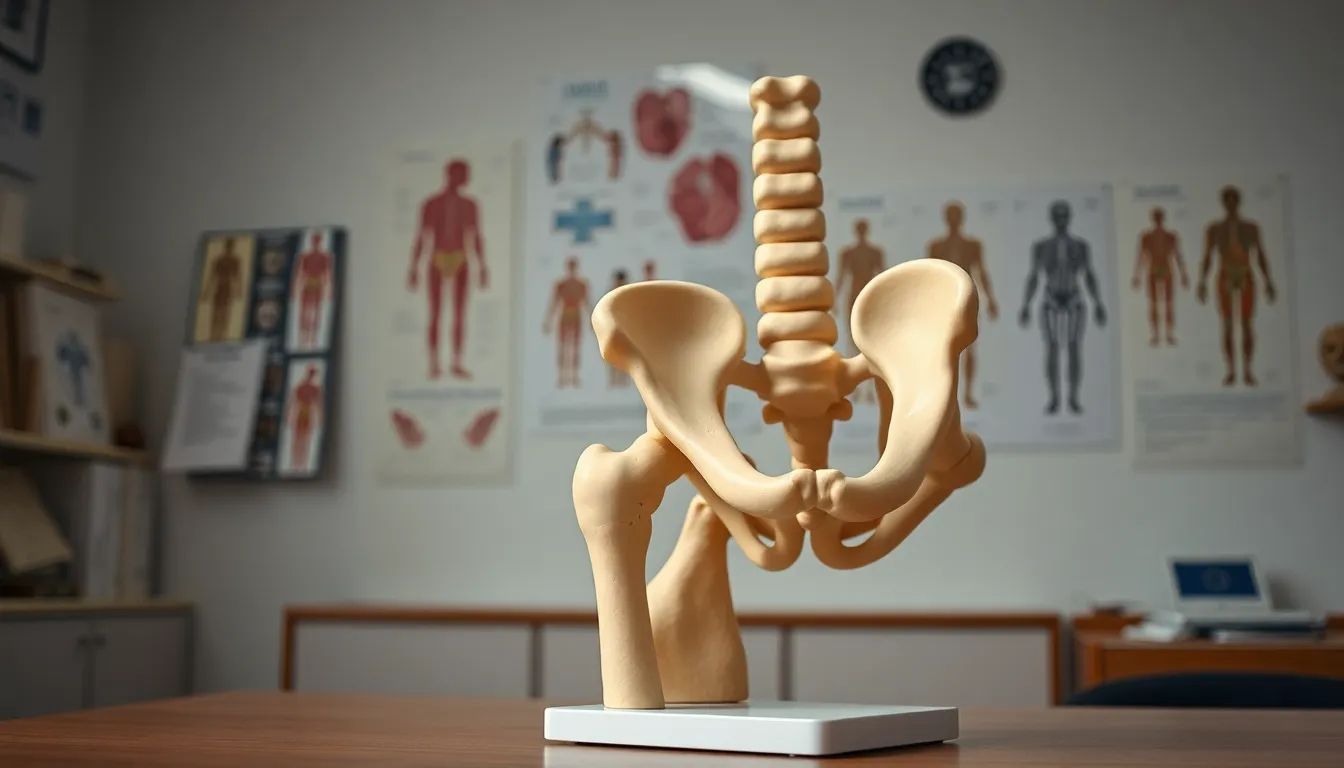Hip dysplasia isn’t just a puppy problem; it can sneak up on adults too, often leaving them feeling like they’re auditioning for a role in a low-budget horror film called “The Stiffness.” This condition, where the hip joint doesn’t fit snugly into the socket, can lead to discomfort and mobility issues that make even the simplest tasks feel like climbing Mount Everest.
Ignoring untreated hip dysplasia is like ignoring a leaky faucet; it may seem harmless at first, but it can lead to a flood of pain and complications down the line. With the right knowledge, adults can take charge of their hip health and avoid turning their lives into a limping comedy. So let’s dive into the world of untreated hip dysplasia and discover why addressing it sooner rather than later is the best punchline for a happier, more active life.
Table of Contents
ToggleOverview of Untreated Hip Dysplasia in Adults
Untreated hip dysplasia in adults leads to severe complications over time. Joint instability causes significant pain and limits mobility, affecting daily activities like walking or climbing stairs. Osteoarthritis commonly develops in those with this condition due to the abnormal wear and tear on the hip joint.
Symptoms typically include hip pain, a reduced range of motion, and difficulty performing physical activities. Adults may also experience noticeable limping or waddling when walking. These signs stem from the misalignment of the hip joint, which results in inflammation and discomfort.
Research indicates that untreated cases often progress, leading to joint degradation. Many adults report worsening symptoms after initially noticing mild discomfort. Additionally, treating hip dysplasia at early stages shows a higher success rate, while neglecting it increases the chance of requiring surgery later.
Lifestyle changes play a vital role in managing symptoms. Weight management can reduce strain on the hip joint, while specific exercises strengthen surrounding muscles. Physical therapy offers strategies to improve joint function and alleviate pain effectively.
Without treatment, individuals face a greater risk of developing chronic conditions. Some might develop additional complications, such as referred pain in areas like the knees or lower back. Seeking help from healthcare professionals ensures proper diagnosis and treatment plans, ultimately preserving an active lifestyle.
Causes and Risk Factors

Understanding the causes and risk factors of untreated hip dysplasia in adults is essential. Both genetic and environmental factors play significant roles in the development of this condition.
Genetic Predisposition
Genetics significantly influences the likelihood of developing hip dysplasia. Studies indicate that certain breeds, such as large breed dogs, exhibit a higher prevalence of the condition. Family history also contributes, as individuals with relatives who experienced hip dysplasia face increased risks. Genetic mutations affecting hip joint formation can lead to improper alignment and destabilization over time. Research has shown that people with a direct bloodline connection to affected individuals must be vigilant regarding their hip health. The presence of these genetic factors underscores the importance of monitoring one’s condition, especially if symptoms begin to arise.
Environmental Influences
Environmental factors also contribute to the onset of hip dysplasia. Lifestyle choices, including excessive weight, can exacerbate the condition. Engaging in high-impact sports or activities increases stress on the hip joints, potentially accelerating joint damage. Additionally, inadequate nutrition plays a crucial role, as a lack of essential nutrients affects bone and joint health. Injuries sustained from falls or accidents may also trigger the onset of symptoms. Awareness of these environmental influences helps individuals recognize risk factors and take proactive steps in managing their hip health.
Symptoms and Diagnosis
Recognizing symptoms of untreated hip dysplasia in adults is crucial for timely intervention. Symptoms often signal the progression of the condition.
Common Symptoms
Hip pain manifests during routine activities, including walking and climbing stairs. Individuals may notice a reduced range of motion in their hips. Limping or a waddling gait often becomes apparent when weight-bearing activities are involved. Others may experience stiffness after periods of inactivity. Joint swelling can occur, indicating inflammation around the hip. With time, symptoms may intensify, impacting daily life and preventing engagement in previous routines.
Diagnostic Techniques
Healthcare professionals utilize various diagnostic techniques to assess hip dysplasia. X-rays provide visual insight into joint alignment and any degenerative changes. MRI scans offer detailed images of soft tissues around the joint, enhancing understanding of hip health. Physical examinations reveal mobility limitations and pain triggers. A thorough patient history allows for identifying contributing factors and accurately diagnosing the condition. Early detection through these methods enables more effective management strategies, optimizing quality of life for affected individuals.
Treatment Options for Untreated Cases
Various effective treatment options exist for adults with untreated hip dysplasia. These methods aim to relieve symptoms, improve mobility, and enhance overall quality of life.
Non-Surgical Approaches
Conservative management includes physical therapy to strengthen the muscles surrounding the hip joint. Weight management plays a vital role, as reducing excess weight lowers stress on the joint. Activity modifications can significantly lessen pain; low-impact exercises such as swimming or cycling provide relief. Medications like non-steroidal anti-inflammatory drugs (NSAIDs) alleviate discomfort. In some cases, supportive devices such as braces or canes improve stability. Many adults benefit from complementary therapies, including acupuncture or chiropractic care, which may provide additional pain relief.
Surgical Interventions
Surgical options become necessary when non-surgical methods fail to improve symptoms. Hip arthroscopy serves to remove loose fragments and repair soft tissue within the joint. Osteoplasty reshapes the bone to enhance stability and function. In severe cases, hip replacement surgery offers a long-term solution by replacing the damaged joint with a prosthetic one. Surgical decisions depend on individual factors, such as age, activity level, and degree of joint damage. Consultation with orthopedic specialists ensures the selection of the most appropriate intervention for each patient.
Prognosis and Long-Term Effects
Untreated hip dysplasia in adults can lead to severe long-term consequences. Over time, joint instability often worsens, resulting in intensified pain and mobility issues. Many individuals experience increased difficulty with activities like walking and climbing stairs. Osteoarthritis tends to develop due to ongoing joint wear and tear, which leads to chronic discomfort.
Symptom progression often varies among individuals, but common experiences include noticeable limping and reduced range of motion. Research indicates that untreated cases can fall into a downward spiral, worsening functional capabilities and elevating the need for surgical interventions. Studies show individuals with hip dysplasia who ignore symptoms face escalating complications and diminished quality of life.
Frequent monitoring of joint health plays a critical role in maintaining well-being. Lifestyle modifications, such as effective weight management and tailored exercise programs, significantly impact symptom control. Regular consultations with healthcare professionals help in developing individual management strategies aimed at slowing down the condition’s progression.
Consequences of untreated hip dysplasia extend to emotional health as well. Frustration stemming from limited mobility can contribute to anxiety and low mood. Engaging in supportive activities, such as community exercise groups, offers social interaction and encouragement, which counteracts feelings of isolation.
Long-term management of hip dysplasia requires proactive engagement from patients. Individuals must stay informed about their condition and pursue timely interventions. Staying educated about symptoms and treatment options can improve outcomes significantly, ensuring that many maintain an active lifestyle despite the challenges of hip dysplasia.
Untreated hip dysplasia in adults poses significant risks that can severely impact quality of life. As symptoms progress, individuals may face increased pain and limited mobility, making everyday activities challenging. Proactive management is essential to mitigate these effects. By recognizing symptoms early and seeking professional guidance, individuals can explore effective treatment options tailored to their needs.
Engaging in lifestyle modifications and staying informed about the condition can lead to better outcomes. Ultimately, taking control of hip health is vital for maintaining an active and fulfilling life despite the challenges posed by hip dysplasia.





